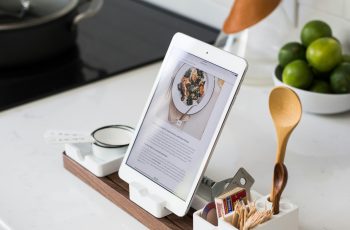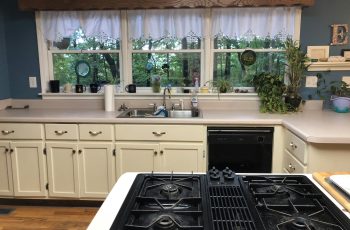Ad Blocker Detected
Our website is made possible by displaying online advertisements to our visitors. Please consider supporting us by disabling your ad blocker.
Are you a fan of gluten-free cooking but find it challenging to prepare meals quickly? Look no further! In this article, we will explore the wonders of gluten-free cooking in a stainless steel pressure cooker. Discover how this cooking method can streamline your meal prep, save you time, and ensure delicious gluten-free meals every time. Say goodbye to hours spent in the kitchen and hello to tasty, hassle-free dishes that cater to your gluten-free lifestyle. Let’s dive in and uncover the secrets of gluten-free cooking in a stainless steel pressure cooker!

Benefits of Gluten-Free Cooking
Improved digestive health
When you embrace gluten-free cooking, you are making a positive impact on your digestive health. Gluten, which is a protein found in wheat, barley, and rye, can be difficult for some individuals to digest. By eliminating gluten from your diet, you can alleviate digestive issues such as bloating, gas, and discomfort. This can lead to a healthier and more comfortable digestive system overall.
Increased energy levels
Gluten-free cooking can help boost your energy levels. Many people who have gluten sensitivities or celiac disease often experience fatigue and low energy levels after consuming gluten. By adopting a gluten-free diet, you may find that your energy levels increase, allowing you to feel more vibrant and engaged throughout the day.
Reduced inflammation
Inflammation can be a major cause of discomfort and can contribute to various health issues. For individuals with gluten sensitivities or celiac disease, consuming gluten can trigger an inflammatory response in the body. By switching to gluten-free cooking, you can reduce inflammation and potentially alleviate symptoms associated with conditions such as arthritis and autoimmune disorders.
Weight management
Gluten-free cooking can also play a role in weight management. While not everyone will experience weight loss solely from eliminating gluten, adopting a gluten-free diet often means consuming more whole foods such as fruits, vegetables, and lean proteins. These nutrient-dense foods can contribute to a healthier lifestyle and support weight management goals.
Introduction to Stainless Steel Pressure Cookers
Overview of stainless steel pressure cookers
A stainless steel pressure cooker is a versatile and efficient kitchen tool that can revolutionize your cooking experience. These cookers are made from high-quality stainless steel, which provides excellent durability and even heat distribution. With a stainless steel pressure cooker, you can prepare a variety of dishes, from soups and stews to grains and desserts, in a fraction of the time compared to traditional cooking methods.
Advantages of using stainless steel
There are several advantages to using stainless steel pressure cookers. Firstly, stainless steel is known for its durability, making it a long-lasting investment for your kitchen. Additionally, stainless steel does not react with acidic ingredients, ensuring that your food remains safe to consume and maintaining the taste and color of your dishes. Lastly, stainless steel is non-porous, making it resistant to stains and odors, which simplifies the cleaning process.
How pressure cooking works
Pressure cooking works by trapping steam inside a sealed pot, which increases the pressure and temperature. This intense heat and pressure help break down tough fibers in foods, reducing cooking times significantly. The higher pressure also allows liquids to reach a higher boiling point, which helps to lock in flavors and nutrients. The result is tender and flavorful meals prepared in a fraction of the time compared to conventional cooking methods.
Gluten-Free Cooking in a Stainless Steel Pressure Cooker
Safe and convenient cooking method
Cooking gluten-free meals in a stainless steel pressure cooker is not only safe but also highly convenient. The sealed nature of the pressure cooker prevents gluten cross-contamination, ensuring that your gluten-free dishes remain safe to consume. Additionally, pressure cookers are incredibly versatile and can handle a wide range of ingredients, making them a valuable tool for gluten-free cooking.
Preserving nutrients in gluten-free ingredients
One of the significant benefits of using a pressure cooker for gluten-free cooking is its ability to preserve nutrients in ingredients. The shorter cooking times prevent essential vitamins and minerals from being destroyed, ensuring that you receive optimal nutrition from your gluten-free meals. This is particularly beneficial when cooking whole grains, vegetables, and proteins.
Faster cooking times
With a stainless steel pressure cooker, you can say goodbye to long, labor-intensive cooking processes. Gluten-free grains, such as quinoa and rice, can be cooked to perfection in a matter of minutes, cutting down meal preparation time significantly. This allows you to enjoy wholesome and delicious gluten-free meals, even on busy days.
Flavor enhancement
The high pressure and temperature in a pressure cooker help to intensify the flavors of your gluten-free dishes. The sealed environment allows ingredients to meld together, resulting in rich and flavorful meals. Whether you’re cooking a hearty lentil soup or a flavorful chicken curry, the pressure cooker will enhance the depth and complexity of the flavors, elevating your gluten-free cooking to new heights.
Essential Tools for Gluten-Free Cooking in a Stainless Steel Pressure Cooker
Stainless steel pressure cooker
To embark on your gluten-free cooking journey, you will need a reliable stainless steel pressure cooker. Choose a model that suits your needs and has good safety features. Stainless steel pressure cookers are available in various sizes, so consider the capacity that works best for your household.
Gluten-free ingredients
Stocking your pantry with gluten-free ingredients is essential for successful gluten-free cooking in a pressure cooker. Some staple gluten-free ingredients include rice, quinoa, lentils, beans, vegetables, fruits, and gluten-free flours. Look for certified gluten-free products to ensure that there is no cross-contamination with gluten-containing grains.
Measuring cups and spoons
Accurate measurements are crucial when cooking gluten-free dishes. Invest in a set of reliable measuring cups and spoons to ensure that you follow recipes precisely. This will help achieve the perfect texture and consistency in your gluten-free cooking.
Utensils for stirring and serving
Having durable and heat-resistant utensils for stirring and serving your gluten-free dishes is important. Look for utensils made from materials such as silicone or stainless steel, as they can withstand the pressure cooker’s high temperatures without melting or warping.
Silicone sealing ring
The silicone sealing ring is a crucial component of your stainless steel pressure cooker. It ensures a tight seal to prevent steam from escaping during the cooking process. Regularly check and replace the sealing ring as needed to maintain optimal functioning of your pressure cooker.

Choosing the Right Gluten-Free Ingredients for Pressure Cooking
Gluten-free grains
Gluten-free grains are the foundation of many delicious gluten-free recipes. Quinoa, rice, millet, and buckwheat are just a few examples of gluten-free grains that can be easily cooked in a stainless steel pressure cooker. These grains can be used as a base for pilafs, risottos, or even as a side dish.
Legumes and beans
Legumes and beans are excellent sources of protein and fiber in a gluten-free diet. Lentils, chickpeas, black beans, and kidney beans can be transformed into hearty soups, stews, and chili in a pressure cooker. The high pressure helps soften the beans quickly, reducing cooking times and enhancing their overall flavor.
Vegetables and fruits
Vegetables and fruits are a vital part of any gluten-free diet. Broccoli, carrots, potatoes, and squash can be steamed or cooked in a pressure cooker, preserving their nutrients and vibrant colors. Fruits like apples, pears, and berries can also be used in gluten-free desserts or as toppings for breakfast porridge.
Proteins such as meat, poultry, and seafood
Proteins are an essential component of a well-balanced gluten-free diet. Chicken, beef, pork, and seafood can all be prepared to perfection in a stainless steel pressure cooker. From tender pot roasts to flavorful curries, the pressure cooker will help you create protein-rich meals that are both delicious and gluten-free.
Herbs, spices, and seasonings
Adding flavors and seasonings to your gluten-free dishes is important to keep your meals exciting. Experiment with various herbs, spices, and seasonings to enhance the taste of your gluten-free recipes. From aromatic curries to zesty Mexican-inspired dishes, the possibilities are endless when it comes to gluten-free cooking in a pressure cooker.
Preparing Gluten-Free Recipes for Pressure Cooking
Adapting traditional recipes to be gluten-free
One of the joys of gluten-free cooking is adapting traditional recipes to suit your dietary needs. With some simple substitutions, you can transform your favorite dishes into delicious gluten-free creations. For example, replace wheat-based pasta with gluten-free alternatives like rice or quinoa pasta, and use gluten-free flour blends in place of wheat flour. Experimentation is key, and with time, you’ll become adept at modifying recipes to be gluten-free.
Finding and creating gluten-free pressure cooker recipes
There are countless resources available to help you find and create gluten-free pressure cooker recipes. Online recipe platforms, gluten-free cookbooks, and food blogs are all excellent sources of inspiration. Explore different cuisines and experiment with a variety of ingredients to keep your gluten-free cooking repertoire diverse and exciting.
Meal planning and prepping
Meal planning and prepping can be incredibly helpful when cooking gluten-free meals in a pressure cooker. Plan your meals ahead, taking into consideration any dietary restrictions or preferences. This will ensure that you have all the necessary ingredients on hand and help streamline the cooking process. Prepping ingredients in bulk, such as chopping vegetables or marinating proteins, can save you valuable time during busy weekdays.

Tips for Successful Gluten-Free Pressure Cooking
Properly measuring ingredients
Accurate measurements are crucial when cooking gluten-free dishes, as the right proportions can significantly impact texture and consistency. Follow recipes carefully, using measuring cups and spoons to ensure precise measurements. This attention to detail will help you achieve the best results in your gluten-free pressure cooking endeavors.
Adjusting cooking times for gluten-free ingredients
Gluten-free grains, legumes, and some vegetables may require slightly shorter cooking times compared to their gluten-containing counterparts. Monitor cooking times closely and adjust as needed to avoid overcooking. It’s always better to slightly undercook and continue cooking if necessary, as overcooking can lead to mushy or less desirable textures.
Releasing pressure safely
When using a stainless steel pressure cooker, it’s essential to release pressure safely to avoid accidents or burns. Pressure release methods may vary depending on your pressure cooker model, so familiarize yourself with the specific instructions provided by the manufacturer. Be cautious and allow the pressure to release completely before opening the cooker.
Avoiding cross-contamination with gluten
Cross-contamination with gluten can occur easily if you’re not careful. Keep your gluten-free ingredients separate from any gluten-containing ones to prevent accidental contamination. Use dedicated utensils, cutting boards, and storage containers for gluten-free cooking. It’s also wise to clean all surfaces thoroughly to eliminate any traces of gluten.
Gluten-Free Pressure Cooker Recipe Ideas
Quinoa and vegetable pilaf
Combine cooked quinoa with a variety of sautéed vegetables, such as bell peppers, onions, and zucchini, to create a flavorful and nutritious pilaf. Season with herbs and spices of your choice, and let the pressure cooker work its magic.
Lentil soup
Create a comforting and hearty lentil soup by combining lentils, diced vegetables, and vegetable or chicken broth in the pressure cooker. Customize the flavors with your favorite seasonings and spices, and enjoy a nourishing gluten-free meal.
Chicken curry with gluten-free grains
Prepare a flavorful chicken curry by cooking chicken, vegetables, and Thai curry paste in your pressure cooker. Serve it over gluten-free grains like rice or quinoa for a satisfying and aromatic gluten-free meal.
Fish tacos with gluten-free tortillas
Cook your favorite fish in the pressure cooker with spices and herbs for a quick and flavorful filling for gluten-free tortillas. Top with fresh salsa, guacamole, and shredded cabbage for a delicious lunch or dinner option.
Mixed berry compote
Using a pressure cooker, cook a mixture of your favorite berries with a touch of sweetener to create a delightful mixed berry compote. This versatile condiment can be enjoyed over gluten-free pancakes, yogurt, or even as a topping for ice cream.
Maintaining and Cleaning Your Stainless Steel Pressure Cooker
Proper cleaning techniques
To ensure the longevity of your stainless steel pressure cooker, proper cleaning techniques are essential. After each use, allow the cooker to cool and then wash it with warm, soapy water. Use a soft sponge or cloth to clean the interior and exterior of the cooker, removing any residue or food particles. Pay special attention to the sealing ring and release valve, ensuring they are thoroughly cleaned to prevent odors or clogs.
Removing stains and keeping the cooker in pristine condition
Stains can occasionally occur on the stainless steel surface of your pressure cooker. To remove stains, create a paste using baking soda and water, and gently scrub the stained area. Rinse thoroughly and dry with a soft cloth. Regular maintenance and proper cleaning will help keep your pressure cooker looking and performing at its best.
Storage tips
When not in use, store your stainless steel pressure cooker in a clean and dry location. Ensure that the cooker is completely dry before storing to prevent the growth of bacteria or mold. Store the pressure cooker with its lid slightly open to allow air circulation, which can help prevent any lingering odors.
Conclusion
Summary of the benefits and advantages of gluten-free cooking in a stainless steel pressure cooker
Gluten-free cooking in a stainless steel pressure cooker offers a multitude of benefits. By adopting a gluten-free diet, you can improve your digestive health, boost energy levels, reduce inflammation, and better manage your weight. Stainless steel pressure cookers provide a safe and convenient cooking method, preserving nutrients and enhancing flavors. With the right tools, such as a stainless steel pressure cooker, gluten-free ingredients, measuring cups and spoons, and utensils, you can embark on a successful gluten-free cooking journey.
Final thoughts and encouragement to try gluten-free pressure cooking
Gluten-free cooking in a stainless steel pressure cooker is a fantastic way to explore new flavors and enjoy nutritious meals. Whether you are adapting traditional recipes or creating new ones, the versatility and efficiency of a pressure cooker will elevate your gluten-free cooking experience. Embrace the benefits of gluten-free cooking while enjoying the convenience and time-saving aspects of a stainless steel pressure cooker. Get creative, have fun in the kitchen, and savor the delicious results of gluten-free pressure cooking.

